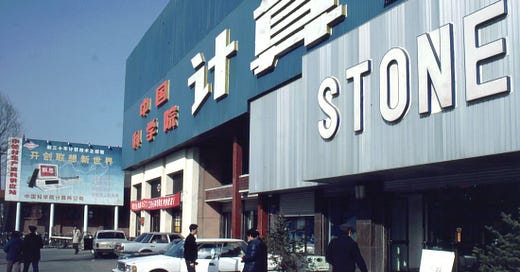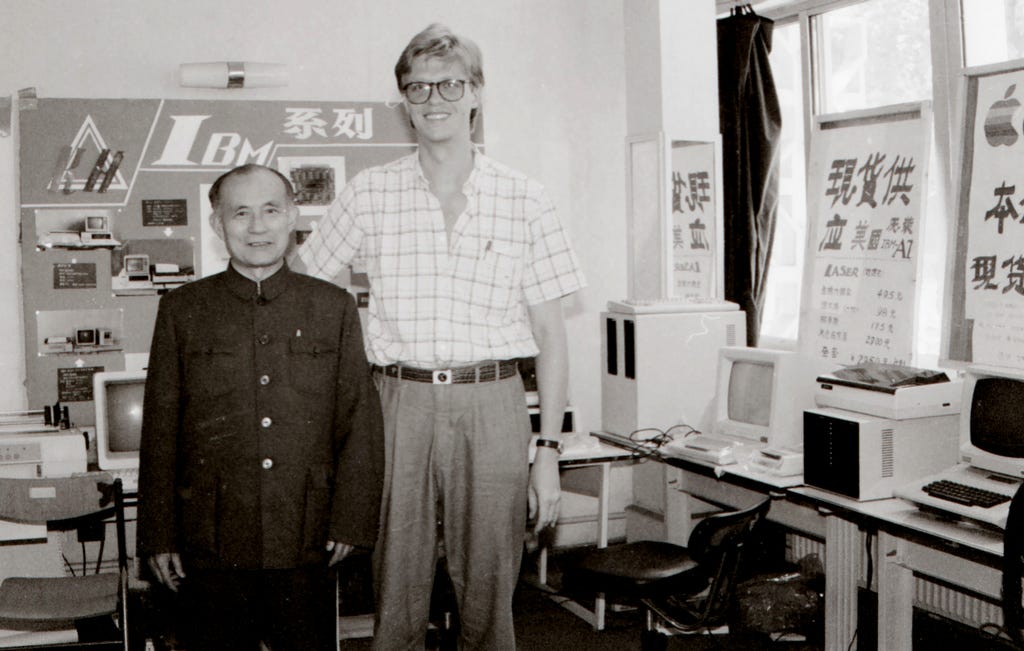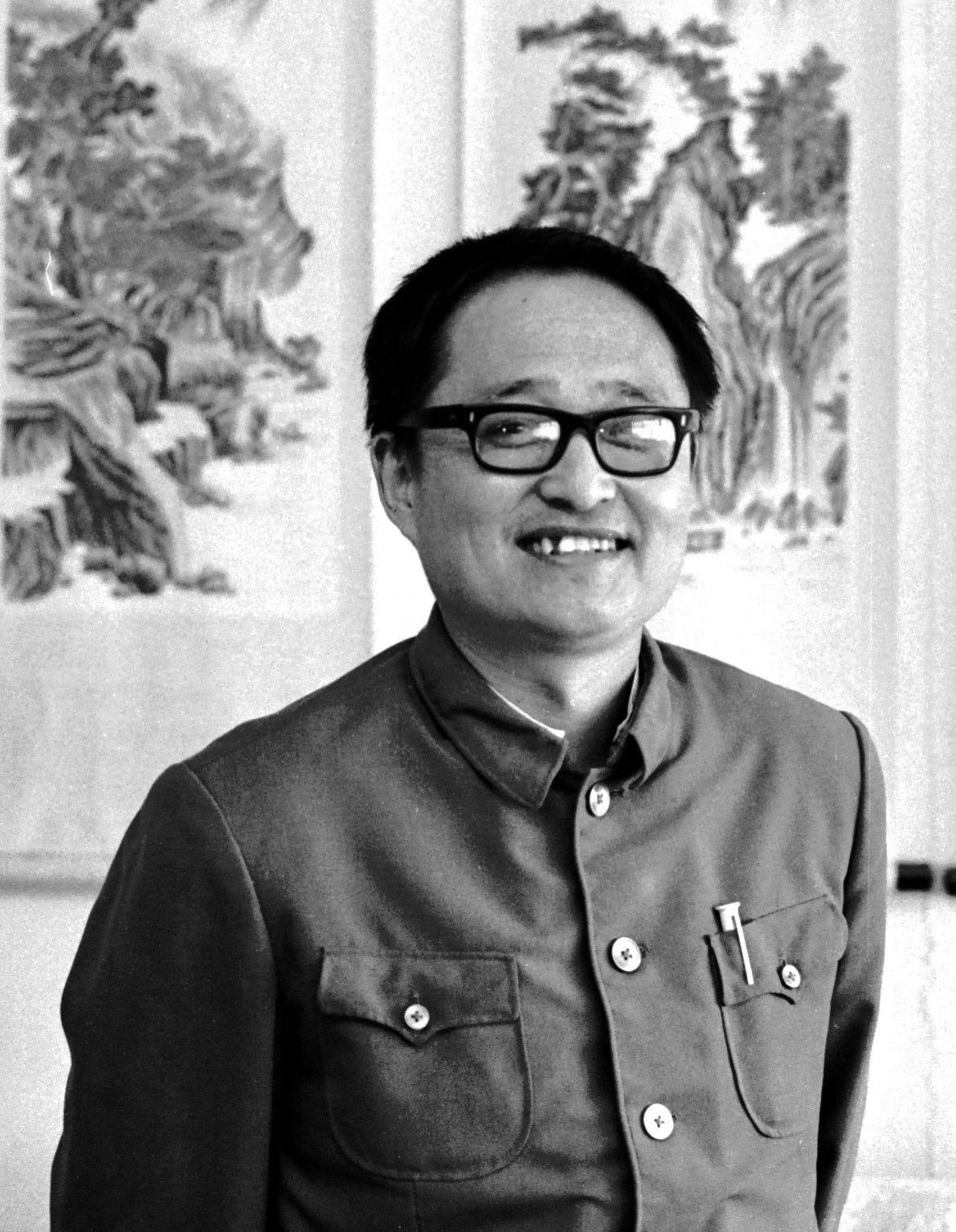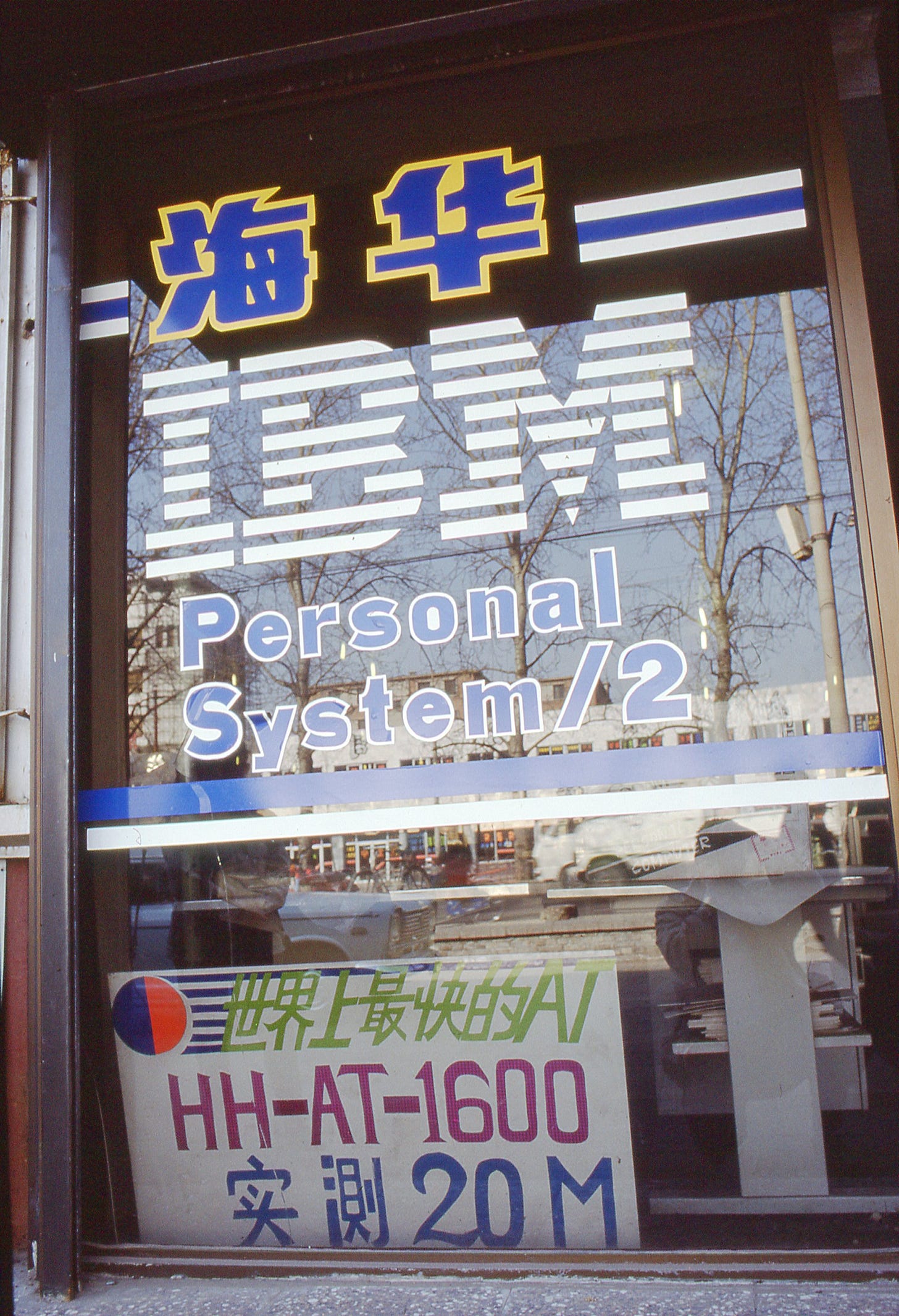(A shorter version of this article was scheduled to be published in the International Herald Tribune on June 4th, 1989, but this did not happen due to the Tiananmen crackdown. The version below ran on May 21, 1989 in Dagens Nyheter, a morning newspaper in Stockholm, Sweden.)

"Our success is a success for the market economy. Stone's way is the way out for China's economy," says Wan Runnan, founder of one of the country's most successful electronics companies.
A spirit of freedom and enterprise has given rise to new kinds of Chinese companies and leaders. The Stone Group, nicknamed "China's IBM," is one of them. China's new entrepreneurs challenge the country's ossified economic system as radically as the students challenge its ossified political system.
Stone Group is headquartered close to the Summer Palace in a 100-square-kilometer area dubbed Beijing's Silicon Valley. The original version n California has long been a veritable hothouse where new ideas are quickly translated into new products and new businesses. Its success has encouraged other states and countries to create their own silicon valleys. So too in China.
My first visit to Beijing's Silicon Valley was in May 1985. Professor Wu Jikang, who helped build China's first computer in 1958, took me for a walk along Haidian Road. We visited computer shops selling imported personal computers, home-made IBM PC clones and Chinese computer program manuals. I was however more impressed with the Chinese supercomputer he showed me at the Institute of Computer Technology (ICT), where he was the director.
When I revisited the Haidian district in March 1989, I found it difficult to recognize the area which is now teeming with computer and electronics companies, not only on Haidian lu but as far as the eye can see.
Last spring, the government adopted new rules for the area, whose official name is the Beijing Industrial Experimental Zone for New Technology Development (BEZ). New companies pay no taxes for the first three years and pay reduced taxes for the next three years. Investment in this area is nothing new. About 10 billion dollars have been invested here since 1949. There are 80,000 scientists and technicians working at 50 universities and 138 research institutes in the zone.
What is new is the attempt to break down the watertight barriers that have hindered cooperation between research and industry in China. Scientists are leaving their ivory towers to start new companies or to work in special institutes for the commercialization of research results.
11,000 scientists and engineers work in the area's 640 technology companies. Their capital assets amount to 600 million yuan. Eight out of ten companies are involved in electronics. 11 foreign companies have also been set up shop here, including Intel and Hewlett-Packard.
Just one year ago, the number of companies was 150 and the number of employees 3,800. Companies in Beijing's Silicon Valley had a turnover of 18 million yuan in 1984. In 1987 it was 900 million yuan and last year it jumped 56 percent to 1.4 billion yuan. This is China's largest market for computers. Exports from the area quadrupled in 1988, reaching 13 million dollars.
However, there are those who question the talk of China's Silicon Valley. One is Li Yun, director of Beijing Computer Factory No. 3 in northeastern Beijing.
“Silicon Valley, ha! All they do is sell things they bought from vendors abroad. In Chinese, this is called dao jie. It is a popular word that means buying something just to resell it. In Silicon Valley, people develop and manufacture products, but here, they don't develop or produce anything. They just sell," he says.
Gao Jian Yu, vice president of Syntone Corporation, one of the computer companies on Haidian Road, defends Beijing's Silicon Valley.
"In the beginning we only had little experience, so we had to start by getting into the market, but now we have developed more than 80 new products, one of which – a sensor – won a gold medal at a technology fair in West Germany.”
ICT, which belongs to the Chinese Academy of Sciences (CAS), also illustrates these new trends. In 1984, ICT began working along commercial lines and the results have not been long in coming. In 1985, ICT sold 3-million-yuan worth of information technology. Sales increased six-fold the following year and in 1987 sales amounted to 71.4 million yuan.
China imported hundreds of thousands of personal computers in the mid-1980s, creating a need for products that help people use them. The key issue was getting the computers to "speak" Chinese, as only a fraction of Chinese users was proficient in foreign languages. ICT developed a circuit board for Chinese language input on personal computers. Today it sells one thousand "LX Chinese Cards" a month.
The Stone Group is considered China's most successful computer company. It was founded by Wan Runnan and a group of CAS researchers who left their secure jobs to start a new business. They had received a 20,000-yuan loan from the local government.
The company started, not unlike IBM, in a different field from computers. It joined forces with the Japanese electronics group Mitsui to produce a cheap computer printer that could also handle Chinese characters. Mitsui provided the machine and Stone supplied the computer programs that adapted the machine to the Chinese language. It was a success and Mitsui and Stone started a joint venture in the summer of 1987. Stone's most popular product is an electronic typewriter that can handle both Chinese and English. With 20,000 copies sold per year, Stone holds 80 percent of the Chinese market.
Stone Group consists of a parent group with 20 specialized subsidiaries, four joint ventures with foreign companies, and three with domestic companies. The group has 2,000 employees, half of them in Beijing.
In February 1988, the company took over the management of Yunnan's largest electronics company, the Yunnan Electronics Factory (YEF) in Kunming. Stone's PR manager Li Yichuan says that the provincial government wanted to benefit from their management methods. In return, the group receives 40 percent of the profits YEF makes above and beyond the plan.
"Production has doubled since we took over," says Li Yichuan. Before, the company operated under the state plan and not in response to market needs. They had an "iron rice bowl" (i.e. equal pay regardless of work effort), where you can't do anything if the staff don't work well.
"A non-state-owned company like Stone is more vital," he says.
The core of the group is Stone Group Ltd which has 1,000 employees, compared with 64 at the start. The income was 317 million yuan in 1987 and 700 million in 1988.
Stone Group is a joint stock company. The parent company owns 15-million-yuan worth of shares but has also sold shares to the public.
"It was difficult and complicated," says Li Yichuan. "Normally there should be a stock exchange for this, but now we had to go through the Bank of China.”
Why did you decide to sell shares?
“We are aiming for the global market and want to attract investment. Public oversight leads to better corporate governance and the ownership will be clearer.”
Who actually owns the company?
“This is a problem. Formally, it is called non-state collective ownership, but Stone is owned by the employees. We are trying to solve this through shares, but it is a sensitive issue.”
Who runs the company? Is it the managing director or the party’s representative?
"The executive director is the head of the party committee," says Li Yichuan. “We don't have any trade unions yet. There is no need because we have harmonious relations within the company.”
A contributing factor is certainly that salaries are about twice as high as normal. (Salaries in state enterprises and institutions are 120-400 yuan per month).
What distinguishes Stone Group from other companies in China more than anything else is its corporate culture. This is also emphatically stated in the colorful annual report:
“Stone's superiority lies in its independent policy and alert management, guided by market trends and needs. Resources are invested where they make the greatest economic sense, and our staff are employed where their talents can be maximized.”
"State-owned-enterprises have few or none of these characteristics," the annual report states.
Wan Runnan is a true Chinese entrepreneur. With his 30,000 yuan a year, you might even call him a capitalist entrepreneur, but that's not what they say in China, at least not yet. He is 43 years old and comes from a small town in the Jiangsu province southeast of Beijing. He joined the Academy of Sciences' Center for Computer Science after graduating from Tsinghua University in 1970, and later studied computer science in the United States and Japan.
"Stone Group has three advantages," he says when I ask him about the secret of the company's success.
"Firstly, we have replaced the 'iron rice bowl' with a 'clay rice bowl.' Everyone in my company has to work hard to get a good salary.”
“We attach great importance to the market economy. It is still a controversial issue in China whether we should have a market or a planned economy. Stone's success is a success for the market economy. Our way is the way out for China's economy!”
"Thirdly, we have great respect for talented people. We have many such people in China, but they are held back by the old system that made them lazy and stupid. Here, on the other hand, they are smart and hard-working.”
Or as the annual report reads under the heading “'The key to success”: “At Stone, there is only one error we cannot accept and that is to suppress the talents of our staff.”
The Stone Group is sometimes referred to as the IBM of China. Is it the model?
"IBM is very successful, especially in computers," he says. “As for myself, I attended an IBM seminar before I started this company. I was deeply impressed by IBM's products and management methods. But we have specific conditions in China and should not copy them. We have to think for ourselves.”
With such companies, Beijing's Silicon Valley could become more than a dream.
"The modernization of ideas is more important than the four rings of modernization," he says.
Dagens Nyheter, May 21, 1989
Note: Wan Runnan fled China after the Tiananmen crackdown on June 4, 1989 since he had provided financial support to the student movement. People’s Daily wrote on August 17, 1989, that "Wan Runnan picked up a stone — the whole company — and threw it towards Beijing." After his escape he settled in Paris, France.











great idea for a book. Will you give updates on the entities and personalities?